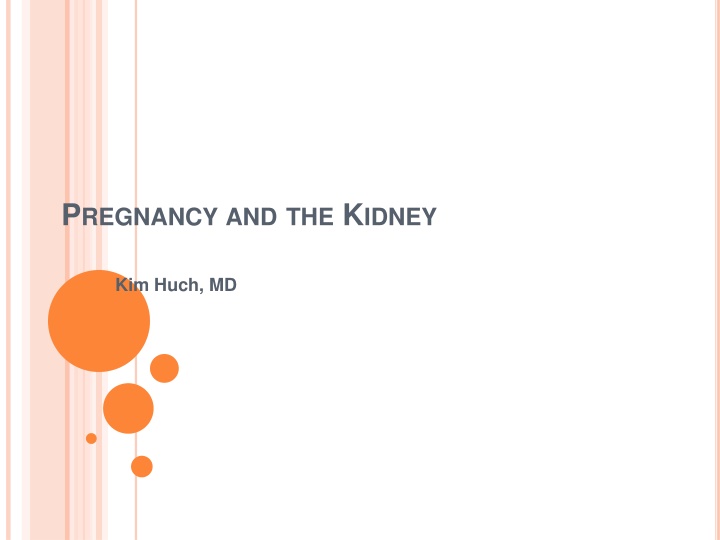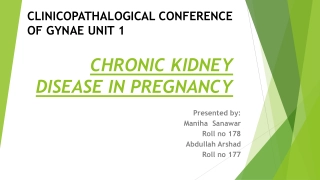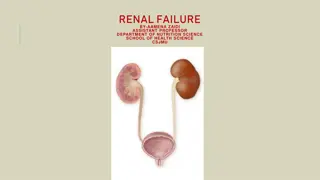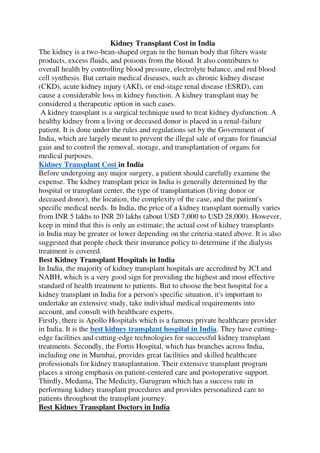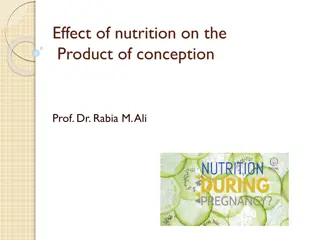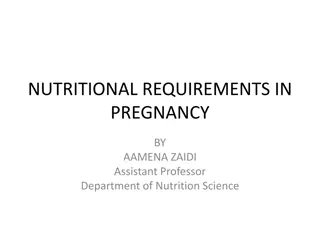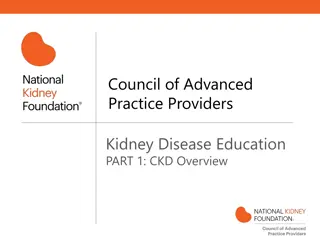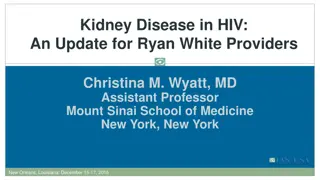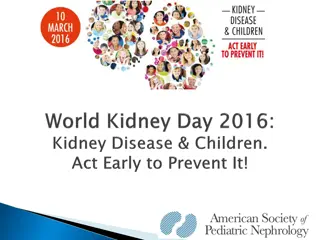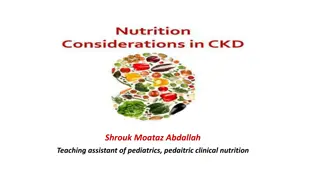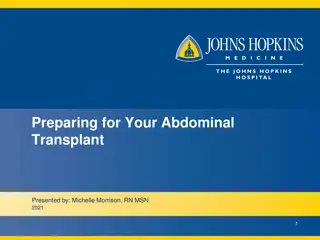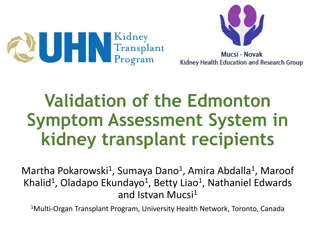Pregnancy and the Kidney: Physiological Changes and Considerations for Chronic Kidney Disease
GB, a 28-year-old woman with a history of FSGS, seeks advice on pregnancy. Physiological changes in pregnancy affect renal function, including increased renal flow and volume, ureteral dilation, and systemic vasodilation. Renal hemodynamics peak in the first trimester without causing kidney damage. Understanding these changes is crucial for assessing renal disease during pregnancy.
Download Presentation

Please find below an Image/Link to download the presentation.
The content on the website is provided AS IS for your information and personal use only. It may not be sold, licensed, or shared on other websites without obtaining consent from the author.If you encounter any issues during the download, it is possible that the publisher has removed the file from their server.
You are allowed to download the files provided on this website for personal or commercial use, subject to the condition that they are used lawfully. All files are the property of their respective owners.
The content on the website is provided AS IS for your information and personal use only. It may not be sold, licensed, or shared on other websites without obtaining consent from the author.
E N D
Presentation Transcript
PREGNANCY AND THE KIDNEY Kim Huch, MD
GB IS A 28 YEAR OLD WOMAN WITH H/O FSGS BIOPSIED A COUPLE OF YEARS EARLIER WHEN SHE PRESENTED WITH NEPHROTIC RANGE PROTEINURIA AND EDEMA. SHE WANTED TO HAVE A CHILD AND ASKED FOR ADVICE. MEDS: LISINOPRIL 40 MG Q DAY LASIX 40MG BID ON PE HER BP WAS 130/80. 1+ LE EDEMA WAS PRESENT. LABS: LYTES NORMAL. SCR 2.1MG/DL (BASELINE) HGB 12. U/A WITH TRACE PROTEINURIA O/W NORMAL DIPSTICK. WHAT ADVICE CAN YOU GIVE TO HER??
GOALS: -- UNDERSTAND THE PHYSIOLOGIC CHANGES ASSOCIATED WITH PREGNANCY -- LEARN THE POTENTIALLY HARMFUL EFFECTS OF CKD ON PREGNANCY OUTCOME AND RENAL FUNCTION -- KNOW HOW TO ASSESS RENAL DISEASE IN PREGNANCY
CHANGES ASSOCIATED WITH PREGNANCY Increased renal flow and glomerular hypertrophy Increased kidney length of about 1 cm Increased kidney volume of up to 30% Anatomic changes of the collection system with dilation of R>L with appearance of obstructive uropathy (but not so) Stasis of urine with increased risk of infection Overdistension syndrome with symptoms
SYSTEMIC CHANGES Marked vasodilation @ 6 weeks gestation Decreased Blood Pressure Increased Cardiac Output Increased Renal Plasma Flow Increased Glomerular Filtration Rate Etiology: Progesterone, Estrogen, Nitric Oxide, Relaxin
THE EFFECT ON RENAL HEMODYNAMICS Filtration fraction may be unchanged or reduced (RPF > GFR) Renal hemodynamics reach max during first trimester and are about 50% above pre-pregnancy levels The increase GFR has no increased glomerular pressure -> so, no maternal kidney damage results from normal pregnancy
OTHER PHYSIOLOGIC CHANGES Acid/Base -> Respiratory Alkalosis 2o progesterone stimulation of medullary respiratory center (HCO320-22 and low pCO2) Water balance -> Decreased plasma osm by 5-10 mOsm/kg with nadir @ 10 weeks gestation Etiology: Reset osmostat and increased metabolism of AVP by placental vasopressinases Potential complication is transient DI requiring desmopressin
CONTD Volume regulation Increased TBW 6-8L with 4-6 extracellular Increased PV 50% (largest increase midpregnancy) Increased TBNa by 900 mEq (about 20 gr NaCl) May all be induced by the vasodilation (has lower BP and stimulation of renin-angiotensin system)
Relaxin Peptide hormone in the insulin family secreted by corpus luteum and placenta Associated with osmoregulatory changes, increased GFR, and vasodilation hCG seems to stimulate release -> stimulates hypothalmus -> increases thirst and AVP secretion
ASSESSMENTOFRENALFUNCTION GFR and creatinine clearance increase by 40-65% without change in creatinine production Average values of Scr 0.74, 0.58, 0.53mg/dL in each of the trimesters (baseline 0.83mg/dL) Cockroft-Gault and MDRD have not been validated in pregnancy Measurement of Cystatin C has been proposed but not proven Creatinine Clearance is best-validated method
PROTEINURIA Increased GFR will exceed max tubular transport mechanisms with increased glucose, amino acids, calcium, and protein excretion Abnormal Proteinuria >300mg/d (vs 150mg/d) Correlates with dipstick of 1+ Negative dipstick of value in ruling out proteinuria Urine protein:creatinine underestimates Gold standard is 24 hour urine collection
PROTEINURIACONTD Most common etiology is preeclampsia (second of pregnancy) and is usually preceded by hypertension Without preeclampsia or UTI, think of primary glomerular diseases or systemic disease (DM, SLE) More on this in a bit
HEMATURIA 15-25% will have hematuria at some point in pregnancy 75% will resolve after delivery Most common etiology is vaginal bleed or UTI Not necessarily associated with increased risk of preeclampsia, hypertension, preterm Urine culture; USG to r/o stones (stone incidence 0.03-1%, similar to nonpregnant state)
CKD ANDRENALDISEASEINPREGNANCY Not a lot of quality literature Prevalence of CKD in women of child-bearing age is 0.03-0.2% of all pregnancies Renal disease may preexist and be known, preexist and be discovered during pregnancy, or be new onset in pregnancy Ability to sustain pregnancy depends primarily on renal function and blood pressure rather than etiology of disease
Renal function may decline irreversibly during gestation and after delivery Etiologies: exacerbation of preexistent endothelial dysfunction, alterations in immune system, or increased inflammation in pregnancy
CKD ANDOUTCOMES Normal BP/renal fxn Good outcome Mild CKD (1.2-1.4mg/dl) 16% decline in renal fxn Mod CKD (1.4-2.5mg/dl) 20-30% preeclampsia Increase preterm del 50% decline in renal fxn (by 25%) that persists or progresses
CKD ANDOUTCOMES Severe CKD (>2.5mg/dL) 70% preterm 40% preeclampsia 40% decline to dialysis Increased urinary protein excretion has worse outcome Rate of decline in GFR accelerated in subgroup with eGFR <40cc/min and proteinuria >1 gram/day prior to pregnancy
SYSTEMIC DISEASES Diabetes Most common medical disorder of pregnancy Mostly gestational diabetes Increased risk of UTI and preeclampsia Type 1 DM studied: No micral/nl renal fxn Micral/nl renal fxn Overt DM nephropathy 35% preterm/6% preeclampsia 62% preterm/42% preeclampsia 91% preterm/64% preeclampsia
DIABETES Similar rates of deterioration in renal function over 16 year f/u in Type I DM compared to matched nulliparous controls Urinary protein excretion will increase during pregnancy, sometimes to nephrotic range (usually reversible) BP control is important; must avoid ACEi/ARB in all 3 trimesters (methyldopa,labetalol,nifedipine) Can use Enalapril while breast feeding Recommendation: if only micral, good renal function and BP, proceed with pregnancy early Data not available for Type II DM and pregnancy
SYSTEMIC LUPUS ERYTHEMATOSIS Much more unpredictable disease Pregnancy duration, total disease duration, and disease activity and damage before pregnancy are associated with increased organ damage after pregnancy Prospective data suggest pregnancy is associated with greater risk of flare Wait for 6 months inactivity of disease (Scr <0.7mg/dl, proteinuria <0.5g/d, bland urine)
SLE CONTD 25-50% fetal loss when conception occurs during active disease and Scr >1.2mg/dl Other complications: Maternal autoantibodies causing fetal heart block Antiphospholipid Ab asso d with 50-75% fetal loss, htn, thrombotic events Difficult to discern flare from preeclampsia Hypocomplementemia, onset earlier than 20week, RBC casts favor SLE Increased LFT s more likely preeclampsia
ANDYETMOREONLUPUS Treatment of lupus during pregnancy anecdotal Steroids and azathioprine are mainstays Hydroxycloroquine not toxic to fetus Cyclophosphamide only if mom s life in jeopardy Mycophenolate mofetil associated with fetal malformations
OTHERDISEASES Polycystic Kidney Disease Frequently asymptomatic and undiagnosed Increased risk if HTN ve Increased risk for infection Concern of expanding liver cysts and cerebral aneurysm (prior to delivery, consider screening if + family hx) Genetic counseling Chronic Pyelonephritis Reflux nephropathy with poor outcomes 24% preeclampsia, 18% decline in renal fxn, 33% preterm, 45% with VUR High fluid intake, monitor urine cxs, suppressive antibiotics
HYPERTENSION De novo, Preexisting, Preeclampsia BP > 140/90 Affects 10-12% of all pregnancies Primary Hypertension Secondary Hypertension Preeclampsia Gestational HTN 19% 4% The Rest 34%
NEW PRESENTATIONOF CHRONIC RENAL DISEASE Underlying disease may be identified due to the increased scrutiny of U/A and BP, altered hemodynamics leading to measureable proteinuria, or with preeclampsia due to increased risk in CKD Differential diagnoses: IgA, FSGS or other GN s, PCKD, Reflux nephropathy, renal impairment associated with Systemic Disease
PREECLAMPSIA VS PREEXISTING CKD Preeclampsia: proteinuria, edema, hypertension at >20 weeks gestation Hypertension preceeds or accompanies onset of proteinuria Virtually never before 20 weeks No hematuria and bland urine Increased Uric Acid >8.5 mg/dL
ROLEOFRENALBIOPSY Usually reserved for worsening renal function or nephrotic syndrome of uncertain etiology Study by Day, et al evaluated kidney biopsies in 20 pregnant women and 75 postpartum women
FINDINGS During pregnancy: 19/20 (95%) with glomerular disorder 9/20 (40%) with change in management 17/20 (85%) with live infant delivered F/U (median 103 months): 9/20 with CKD (eGFR <60 with 6 at ESRD) 3/20 maternal deaths
MOREFINDINGS Post partum: 62/75 (82.6%) with significant proteinuria during pregnancy and persisting post partum 64% had glomerular lesion F/U of 47 of the 75 (median 51.5 months): 14 with significant proteinuria 20 with eGFR <60cc/min 6 with ESRD
Biopsies in first trimester with structurally normal kidneys, active urinary sediment, NS, unexplained CKD, positive serologies In the second trimester, unexplained NS, progressive CKD, and renal disease with active systemic disease After 28 weeks, wait for delivery and biopsy post-partum Less severe disease, also biopsy postpartum (6 months)
PREGNANCYINDIALYSIS Anecdotal reports in the literature Extremely high risk to fetus with preterm birth, low birth weight, and IUGR Live birth in 42-60% Management: Frequent dialysis with goal predialysis urea 30-50mg/dL Minimum 20hrs/week Bicarbonate bath decreased to 25mEq/L Minimal heparinization; consider adding ASA for possible prevention of preeclampsia Increase dry wt about 1 lb a week after 1st trimester Increase protein intake, maintain Hgb, avoid sevelemer
PREGNANCYINRENALTRANSPLANTATION More successful with >90% births but high incidence of preterm and low birth weight Immunosuppressant effects, preexisting hypertension, CKD can cause complications No adverse effect on renal function in large series Guidelines: Good health and stable renal function 1-2 years Proteinuria <0.5gm/day; Normal or controlled BP No pelvicalcyeal distention on USG prior to conception Serum creatinine <1.5mg/dL Drug therapy: Prednisone 15 mg, Azathioprine 2mg/kg, Cyclosporine 5mg/kg; Tacrolimus may be safe
SO BACKTOOURPATIENT SHEFELTSHEWASGOINGTOPROGRESSTO DIALYSISANDWASUNCONCERNEDABOUT PROGRESSIONOFDISEASE. WASGOINGTO TRYTOHAVEACHILDNOMATTERWHATADVICE WASGIVENTOHER.
GB ISA 28 YEAROLDWOMANWITHH/O FSGS BIOPSIEDACOUPLEOFYEARSEARLIERWHENSHE PRESENTEDWITHNEPHROTICRANGEPROTEINURIA ANDEDEMA. SHEWANTEDTOHAVEACHILDAND ASKEDFORADVICE. MEDS: LISINOPRIL 40 MGQDAY LASIX 40MGBID ON PE HER BP WAS130/80. 1+ LE EDEMAWAS PRESENT. LABS: LYTESNORMAL. SCR 2.1MG/DL (BASELINE) HGB 12. U/A WITHTRACEPROTEINURIAO/W NORMALDIPSTICK. WHATADVICECANYOUGIVETOHER??
COURSE: CONCEIVED 3 TIMESWITHFIRST 2 ENDINGIN MISCARRIAGEINFIRSTTRIMESTER. CARRIEDHERLASTPREGNANCYINTOTHE 3RD TRIMESTERBUTHADPRETERMLABORAND DELIVEREDASONWHODIEDSHORTLYAFTER BIRTH. EVENTUALLYSTARTED PD ANDLAST I SAWOF HER, SHEWASONTHETRANSPLANTLIST.
